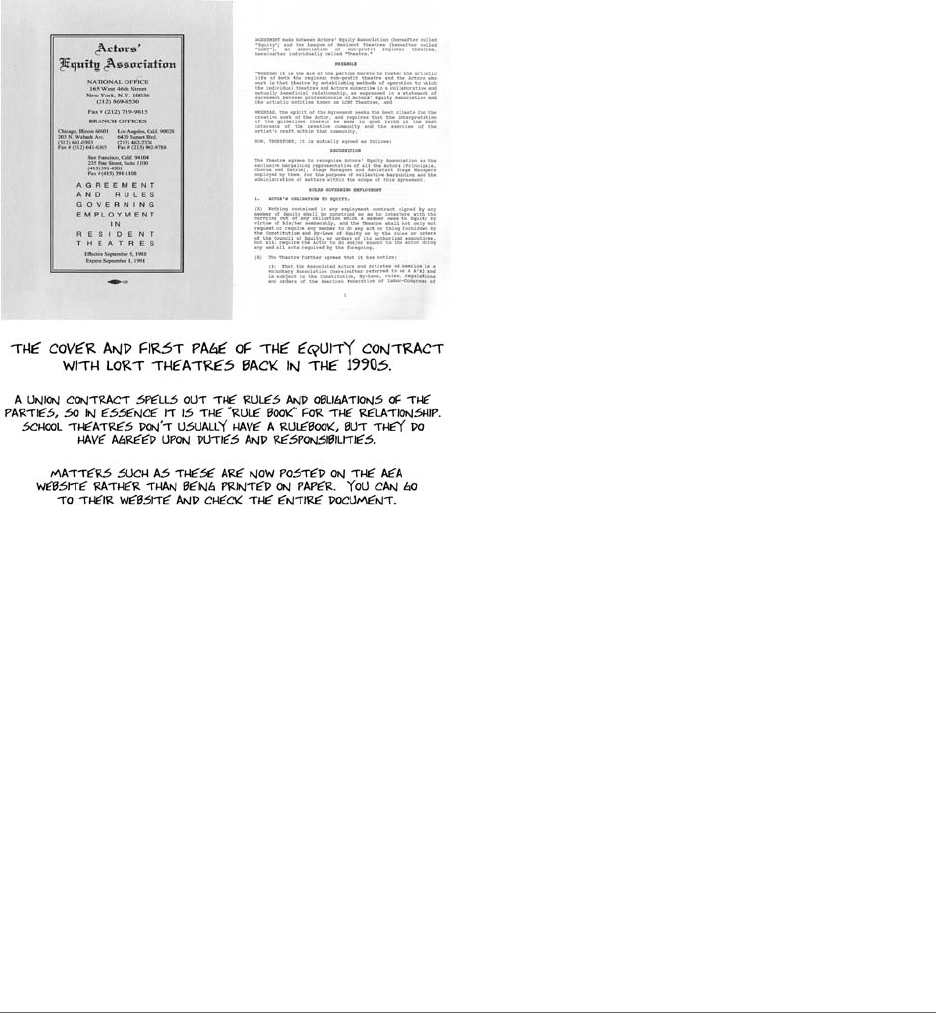
186 Illustrated Theatre Production Guide 2 ed
In a school setting, where students serve as stage
manager, the role of stage manager (SM) is generally
more limited to organizing rehearsals and calling cues
for a show. Each theatre organization is somewhat dif-
ferent, and has its own rules. Equity stage managers
must follow the rules set down in the AEA contract with
their group. Equity has contracts with many different
organizations, but in each case the contract is published
as a booklet that contains all the work rules for that
venue. All unions have work rules, which are used to
define responsibilities, duties, rights, and privileges.
This chapter presents, in a roughly chronological
order, the way things happen, beginning with design
meetings, auditions, the rehearsal process, production
meetings, tech rehearsals, dress rehearsals, and finally
the running of the performances.
FIRST MEETING WITH THE DIRECTOR
At some point, you should have a first meeting with the
director. It is best to do this as early as possible so that
the two of you can discuss how to work together in
putting together the play. You should get some idea of
the director’s artistic view of the piece, and find out how
the director would like the process to develop. Some
directors like to shape the production organically, or in
a loose manner. Others are much more structured. Be
sure to ask questions about this particular director’s
process. Be honest with the director. If you don’t have
any experience in a particular area, let him or her know
so that he or she can help you learn.
DESIGN MEETINGS
Sometime early on, weeks or maybe months before
rehearsals begin, designers will start working with the
director to solidify the way the show will look and
sound. The role of the stage manager in these meetings
is to take notes of the ideas that are put forward and
to publish a record of the discussions. This will help
keep the director and the designers on track with one
another. A bit of efficiency on your part will greatly aid
the process. Be sure to disseminate the notes as quickly
as possible, as they are of little use days or weeks
later. Social networking sites can be an excellent
resource for that process, but be careful not to post
sensitive information in a place where the public at large
can find it.
AUDITIONS
There is a wide diversity of style in how directors like
to hold auditions, and the only way for you to find out
how your director works is to ask him or her. Find out
when and where the auditions are to be held. Most
theatre organizations have a place to post information
known as the call board. The director may want you to
post a notice on the call board detailing how actors
should prepare for the auditions. Some directors want
actors to come with a prepared selection. Some choose
to have the actors read from the script of the play that
is being done. Sometimes it is both. There may be
singing or dancing auditions. If actors must read from
a script, make sure that copies are available. Often times,
the scripts will have been ordered in advance, but if not,
you will need to make copies of the pertinent pages for
use at the auditions.
It is usually best to set up a table in the theatre to
use in processing the auditionees. This will give you a
place to lay the scripts and the audition forms. Consult
with the director about what information should be
required on the audition form, but the most obvious
data should be name, phone number, email address, sex,
height, weight, hair color, as well as any activities that
may conflict with the rehearsal schedule. Quite often,
the theatre or the director may have a standard form
already made up. You should expect to make announce-
ments to the auditionees about who the director wants
to see, and to perform other crowd-control duties. Use
Get Illustrated Theatre Production Guide, 2nd Edition now with the O’Reilly learning platform.
O’Reilly members experience books, live events, courses curated by job role, and more from O’Reilly and nearly 200 top publishers.

